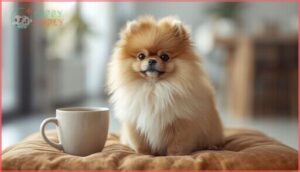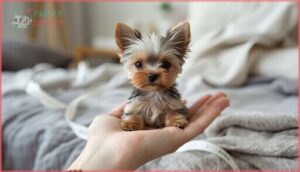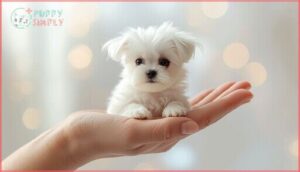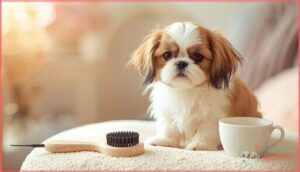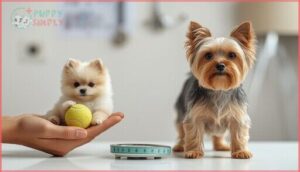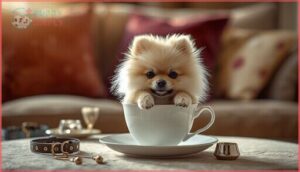This site is supported by our readers. We may earn a commission, at no cost to you, if you purchase through links.
Picture a dog so small, it can curl up in the palm of your hand—lighter than a hardcover book, yet packed with personality. Teacup dogs have captured hearts with their tiny frames and big attitudes, but their size comes with a unique set of challenges that many owners don’t expect.
These pups demand careful attention, from specialized feeding to gentle handling, and their health can be fragile. If you’re drawn to the idea of a pocket-sized companion, understanding what sets teacup dogs apart—and how to care for them—makes all the difference in their happiness and yours.
Table Of Contents
- Key Takeaways
- What Are Teacup Dogs?
- Popular Teacup Dog Breeds
- Key Characteristics of Teacup Dogs
- Health Concerns in Teacup Dogs
- Responsible Teacup Dog Ownership
- Frequently Asked Questions (FAQs)
- How do teacup dogs interact with other pets and children?
- Can teacup dogs be trained for obedience or agility competitions?
- What is the history and origin of specific teacup breeds?
- How do teacup dogs fare in different climates or environments?
- How much exercise do teacup dogs need daily?
- Can teacup dogs travel safely on airplanes?
- Are teacup dogs suitable for families with children?
- What toys are safe for teacup dogs?
- How do teacup dogs handle extreme weather?
- Conclusion
Key Takeaways
- Teacup dogs weigh under 4 pounds and require specialized care, including frequent feeding schedules to prevent hypoglycemia, constant supervision to avoid injury from their fragile bones, and vigilant health monitoring for breed-specific issues like dental disease and heart problems.
- No major kennel club (AKC, UKC, or FCI) officially recognizes “teacup” as a legitimate breed classification—it’s purely a marketing term used to describe the smallest versions of toy breeds, raising ethical concerns about breeding practices that prioritize extreme miniaturization over health.
- These tiny dogs demand significant financial investment through specialized veterinary care, professional grooming every 4-6 weeks, and potential emergency treatments, with lifespans typically ranging from 9-15 years depending on genetics and quality of care.
- Prospective owners should carefully evaluate whether they can meet the intensive daily care requirements and consider healthier alternatives like standard toy breeds (Shih Tzu, Miniature Poodle, Boston Terrier) that offer similar small size with fewer health risks and greater durability.
What Are Teacup Dogs?
Teacup dogs are known for their tiny size and big personalities, but there’s more to them than meets the eye. If you’re curious about what makes these little companions unique, you’re in the right place.
Let’s look at the basics that set teacup dogs apart.
Definition and Size Standards
A teacup dog isn’t just small—it’s bred to be the tiniest version of its breed, often weighing under 4 pounds and standing less than 8 inches tall. You’ll notice:
- Weight thresholds below toy breeds
- Height variations among types
- Breed discrepancies in standards
- Terminology origins rooted in marketing
- Teacup dog characteristics shaped by selective breeding
These dogs often exhibit a petite physical presence.
Origins and Popularity
Selective breeding for smaller companions traces back 12,000 years to the Middle East, but teacup dog breed origins as a distinct category emerged around 2005. Celebrity influence—think Paris Hilton and Justin Bieber—fueled teacup dog breed popularity across social media. Today’s market reflects urban demand, with over 65% of owners living in cities. However, ethical concerns shadow this $1.2 billion industry as breeders chase extreme miniaturization. These breeds are known for their extremely small size.
| Era | Key Development | Impact |
|---|---|---|
| 12,000 B.C. | Ancient ancestry begins with domestication | Foundation for toy breeds |
| 2005 | Teacup breeds emerge as distinct category | Market explosion |
| 2024 | Celebrity influence drives social media trends | $1.2B global valuation |
| Present | Urban demand peaks in metros | 65%+ city-dwelling owners |
| Ongoing | Ethical concerns rise over breeding practices | Regulatory pressure |
Recognition by Breed Clubs
Despite the buzz, you won’t find “teacup” in any American Kennel Club breed standards. No major registry—AKC, UKC, or FCI—recognizes this teacup marketing term as legitimate. Breed club warnings are clear: it’s pure marketing, not an official size classification.
Here’s what reputable kennel clubs say:
- The AKC registers 201 breeds but zero teacup categories
- Parent clubs for Yorkies and Chihuahuas reject undersized variants
- Ethical breeding practices emphasize health over extreme miniaturization
Size classification issues persist because these dogs fall below healthy toy breed minimums.
Popular Teacup Dog Breeds
If you’re curious about which breeds fall into the teacup category, you’ll find that several popular dogs have miniature versions. These pint-sized pups come from well-known breeds that have been bred down to ultra-small sizes.
Let’s look at the most common teacup breeds you’ll encounter and what sets each one apart.
Teacup Pomeranian
Ever wondered how a dog smaller than your morning coffee cup can be so bold? The Teacup Pomeranian packs energy, loyalty, and a feathery double coat into a tiny frame. Size variations range from 3–7 pounds, with dazzling coat colors and lively temperament traits. Watch for health predispositions—ethical breeding practices matter with these popular teacup dogs.
| Size Variations | Coat Colors | Temperament Traits |
|---|---|---|
| 3–7 lbs | Black, cream | Loyal, energetic |
| Under 3 lbs | Orange, sable | Playful, social |
| 6–11 inches | White, merle | Confident, protective |
| Tiny frame | Variety blends | Attention-seeking |
Teacup Chihuahua
Picture a Chihuahua so small it fits in your palm—this is the Teacup Chihuahua. Size limitations mean just 3 pounds and up to 6 inches tall, but genetic predispositions make them prone to health issues like hypoglycemia and fragile bones.
Grooming frequency matters, especially for long-haired types, and climate sensitivity means sweaters are a must. Ethical breeding is essential for these tiny companions.
Teacup Yorkshire Terrier
A Teacup Yorkshire Terrier, or Yorkie, stands under 7 inches tall and weighs just 2–4 pounds—making Yorkie size perfect for apartment living. Their fine, silky hair demands daily grooming, and fragile bones mean gentle handling is a must.
Ethical concerns surround Teacup dogs, so consider adoption options and be aware of Teacup dog health issues before bringing a Yorkie home.
Teacup Maltese
A bundle of pure white silk, the Teacup Maltese stands just 4–6 inches tall—noticeably smaller than standard Maltese. Their affectionate temperament traits make them loyal companions, but their grooming needs are high, with daily brushing required.
You’ll need to watch for health issues like hypoglycemia and dental problems. Lifespan data suggests 12–15 years with proper Teacup dog breed care.
Teacup Shih Tzu
Did you know a Teacup Shih Tzu stands just 5–7 inches tall, yet sports a dazzling array of coat colors? You’ll need daily brushing and regular trims to keep their silky hair tangle-free.
Health risks like hypoglycemia and fragile bones mean careful pet care is essential. Because ethical breeding matters, always ask about health problems before bringing one home.
Distinctions From Toy Breeds
Ever wonder how Teacup dogs truly differ from Toy breeds? The gap isn’t just about teacup dog breed sizes. Consider these distinctions:
- Size Discrepancies: Teacup dogs weigh under 4 pounds, while Toy dog breeds average 4–12 pounds.
- Health Risks: Teacups face more congenital issues and fragility.
- Breeding Ethics: Selective breeding for extreme smallness raises welfare concerns.
Key Characteristics of Teacup Dogs
Teacup dogs may be tiny, but they bring a lot to the table. If you’re curious about what makes these little companions stand out, you’re in the right place.
Let’s look at some of the traits you can expect from teacup breeds.
Personality and Temperament
Isn’t it striking how a teacup dog breed temperament can fill a room, despite their tiny size? These dogs thrive on social behaviors, showing strong attachment and loyalty but are prone to separation anxiety. You’ll notice bursts of energy and occasional defensive aggression, especially around unfamiliar faces. Adaptability is high, yet their personalities demand consistent companionship for a happy, balanced dog temperament.
Intelligence and Trainability
Teacup dog breed temperament goes hand-in-hand with sharp minds. Dog breed training success rates exceed 80% when you start early and use reward-based training techniques. Canine intelligence shines through, though overcoming challenges like stubbornness requires patience. Here’s what matters for dog training:
- Begin socialization between 8-20 weeks for socialization impact
- Train commands by 4-6 months during key cognitive development stages
- Use clicker training for consistent results
- Practice daily mental stimulation activities
- Maintain short, positive sessions to prevent boredom
Grooming and Maintenance Needs
Beyond dog training, small dog care demands consistent grooming to keep your tiny companion healthy. Daily brushing prevents mats that can form within two days for long-haired breeds. Professional grooming costs range from $25-$50 every four to six weeks, though home tools like slicker brushes help maintain their coat between visits. Nail trims every three to four weeks prevent mobility issues, while dental hygiene is crucial—brush your dog’s teeth three times weekly, as 80% of teacup breeds develop dental disease by age three.
| Grooming Task | Frequency | Key Benefit |
|---|---|---|
| Brushing | Daily | Prevents tangles, matting |
| Professional Grooming | Every 4-6 weeks | Maintains coat health, skin sensitivity check |
| Nail Trimming | Every 3-4 weeks | Avoids overgrowth, mobility problems |
| Dental Brushing | 3x per week | Prevents periodontal disease |
Suitability for Small Living Spaces
After grooming, you’ll appreciate how Teacup dogs fit right into small living spaces. Their Space Requirements are minimal—about four square feet does the trick.
City living suits their Urban Adaptability, and Apartment dogs like Yorkies or Maltese thrive with short walks and indoor play. Low Noise Levels and strong Social Proximity make them ideal companions for apartment living.
Health Concerns in Teacup Dogs
Teacup dogs need special attention regarding their health. Their tiny size can bring unique challenges that owners should know about. Here are some important concerns to keep in mind.
Hypoglycemia and Feeding Needs
Ever wondered why teacup dogs need such strict feeding schedules? Their tiny bodies can’t store much energy, so hypoglycemia is a real threat—sometimes striking within hours.
Caring for teacup dogs means precise glucose monitoring, calorie-dense meals, and frequent feeding. Emergency treatment with syrup or honey is often lifesaving, while recurrence prevention hinges on meeting their nutritional requirements and never missing a meal.
Fragility and Injury Risks
Vulnerability is the price of miniature dog charm. With fragile bones, joint problems, and a knack for bone fractures from even minor falls, health concerns for teacup dogs are constant. Respiratory distress and hypoglycemia add to the worry.
Miniature dogs’ irresistible charm comes with constant health worries, from fragile bones to breathing issues and frequent injury risks
Injury prevention means strict supervision, protective barriers, and gentle handling—otherwise, expect frequent veterinary costs for these unique, lovable companions.
Dental and Heart Problems
Tiny mouths come with big dog health problems. Dental disease is common in teacup dogs, thanks to crowded teeth and breed predispositions.
Poor oral hygiene can trigger cardiac risks, like valve disease, making regular veterinary intervention essential.
If you want to avoid serious dog health concerns, brushing, checkups, and prompt care from your veterinarian are key for these miniature companions.
Lifespan Expectations
Every teacup dog’s life span is shaped by breed lifespan, genetic factors, and daily health management. Most live 9 to 15 years, but health problems can shorten this. Specialized veterinary care and careful monitoring make a real difference. Watch for these mortality causes:
- Heart and neurological issues
- Fragile bones and injury risks
- Complications from chronic teacup dog breed health concerns
Responsible Teacup Dog Ownership
Owning a teacup dog comes with special responsibilities that you can’t ignore. There are a few key things you’ll need to keep in mind to keep your tiny companion healthy and safe. Here’s what you should focus on as a responsible owner.
Choosing Ethical Breeders
Looking for a teacup dog? You need more than cute photos—you need proof. Ethical dog breeding means health testing, legal compliance, and facility standards you can see. Reputable breeders offer transparency practices and strict buyer screening, never marketing “teacup” as a selling point. Unethical breeders cut corners, risking heartbreak. Here’s what to watch for:
| Ethical Breeder | Unethical Breeder | Your Experience |
|---|---|---|
| Health records | No documentation | Peace of mind |
| Clean facilities | Hidden location | Trust |
| Open dialogue | Evasive answers | Confidence |
Specialized Veterinary Care
Did you know teacup dogs need sophisticated diagnostics and continuous monitoring to stay healthy? Your vet may use CT scans, endoscopy, or fluoroscopy to catch miniature dog health concerns early.
Cardiac care, hypoglycemia management, and orthopedic issues require specific treatment plans.
These small dogs face unique genetic problems, so specialized veterinary support is essential for long-term dog health.
Daily Care and Safety Precautions
Ever wondered how small dog ownership can feel like walking a tightrope? With teacup dogs, daily care means sticking to strict feeding schedules, guarding against home hazards, and limiting exercise to prevent exhaustion.
Injury prevention is key—think soft bedding and puppy-proofed play areas. Medication safety matters, too.
Regular grooming keeps health problems at bay, ensuring your companion thrives.
Alternatives to Teacup Breeds
If you’re drawn to small dog ownership but worry about size and fragility, healthier toy breeds and miniature dogs offer sturdy frames with playful, small breed personalities.
Popular alternatives like the Shih Tzu, Boston Terrier, and Miniature Poodle balance care demands with fewer health risks.
These toy dogs fit apartment living, giving you companionship without constant worry over injuries.
Frequently Asked Questions (FAQs)
How do teacup dogs interact with other pets and children?
Picture a pint-sized pup meeting a toddler—it’s a delicate dance. Teacup dogs can bond beautifully with children and other pets through proper socialization, but their fragility demands constant supervision to prevent accidental injuries.
Can teacup dogs be trained for obedience or agility competitions?
Yes, teacup dogs can learn obedience and compete in agility trials designed for their size. Training requires patience, positive reinforcement, and scaled equipment.
Their fragility demands careful conditioning, but many successfully earn competitive titles through consistent practice.
What is the history and origin of specific teacup breeds?
As they say, every great dog has a story. Selective breeding history and genetic mutations shaped teacup dog breeds over centuries, with royal influence and modern teacup trends driving breed size origins toward increasingly tiny companions.
How do teacup dogs fare in different climates or environments?
Teacup dog breeds struggle with temperature extremes due to their small size. They’re vulnerable to hypothermia below 50°F and heatstroke in hot, humid conditions, making climate-controlled apartment living their ideal environment.
How much exercise do teacup dogs need daily?
Your tiny companion requires 20–30 minutes of gentle daily activity, split into short sessions. Puppy exercise builds gradually, while senior exercise is modified for mobility.
Routine consistency prevents health impacts across teacup dog breeds with unique exercise needs.
Can teacup dogs travel safely on airplanes?
Flying with small dog breeds poses real risks. Cabin air quality, breed-specific risks like respiratory distress, and airline incident rates all matter. Pre-flight protocols and emergency preparedness help, but teacup dogs face unique health issues given their fragile size.
Are teacup dogs suitable for families with children?
You’d think the tiniest dogs would be perfect for small hands—but that’s where the problem starts. Child safety and supervision needs make teacup dog breeds risky family dogs without strict injury prevention protocols.
What toys are safe for teacup dogs?
You’ll want soft plush toys without stuffing, rubber or silicone options designed for small breeds, and digestible chews.
Always supervise playtime to prevent choking hazards and inspect toys regularly for damage.
How do teacup dogs handle extreme weather?
Extreme weather poses serious threats to tiny breeds. Cold weather risks include hypothermia below 45°F, while heatstroke prevention matters above 75°F.
Protective clothing, indoor confinement, and weather monitoring keep these fragile companions safe.
Conclusion
Tiny treasures with tremendous needs—that’s the reality of teacup dogs. Their palm-sized frames hide big responsibilities, from vigilant health monitoring to constant safety precautions.
Before you commit, weigh the fragility against the devotion these pups inspire. If you’re prepared for specialized care and ethical sourcing, a teacup companion can thrive in your home. But if uncertainty lingers, standard toy breeds offer similar charm with fewer risks.
Choose wisely, and your miniature friend will reward you with outsized affection.
- https://www.healthypawspetinsurance.com/blog/common-health-conditions-teacup-dogs
- https://www.dogster.com/dog-breeds/teacup-dogs
- https://lubbockdogtraining.com/teacup-dog-breeds/
- https://dogtime.com/reference/143553-teacup-puppies-dogs-lifespan-how-long-do-they-live
- https://askavet.com/blogs/news/teacup-dogs-puppies-in-2025-vet-reviewed-guide-to-health-risks-care-ethical-considerations-%F0%9F%90%B6


